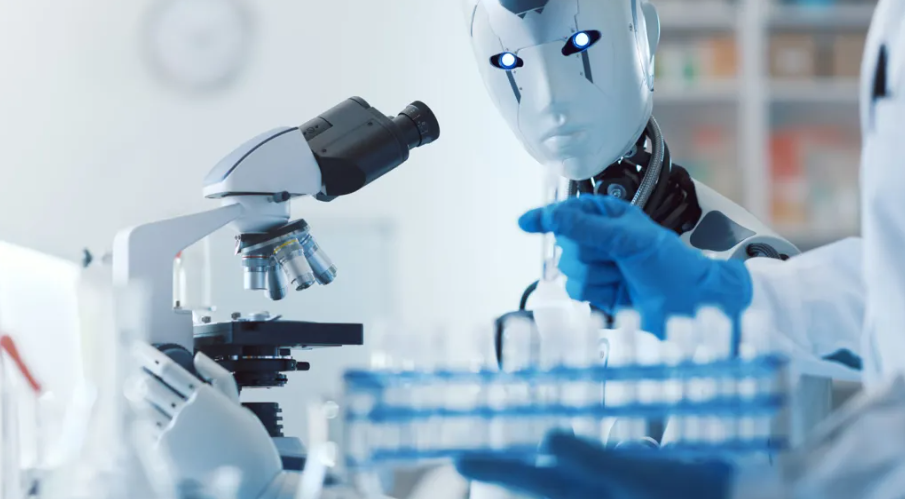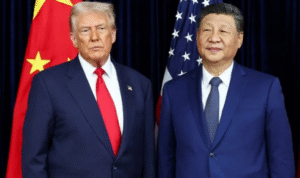How AI Agents Are Transforming Scientific Research: Inside the Groundbreaking Agents4Science 2025 Conference

The Agents4Science 2025 conference made history by allowing AI agents to lead scientific research and paper writing. Discover how artificial intelligence co-authored real studies, challenged traditional peer review, and changed the future of science.
Introduction: A New Era for Artificial Intelligence in Science
In an unprecedented move that could reshape the future of research, the Agents4Science 2025 conference broke long-standing barriers between human and machine collaboration. Held virtually on October 22, 2025, the event invited submissions from all scientific disciplines — but with one radical requirement: AI had to do most of the work.
This first-of-its-kind experiment marks a turning point in how scientists, engineers, and researchers engage with artificial intelligence. Instead of merely serving as a tool for computation or text generation, AI agents — systems that combine large language models (LLMs) with data analysis and automation capabilities — acted as co-scientists.
From formulating hypotheses and analyzing data to drafting research papers and conducting peer review, these AI systems were responsible for executing every major step of the scientific process.
The Birth of Agents4Science: A Conference Like No Other
The event was spearheaded by James Zou, a computer scientist at Stanford University, and his team, who envisioned it as a testbed for exploring AI’s scientific potential. Zou described the initiative as an “open experiment” — all data, code, and review processes are publicly available for independent evaluation.
In total, the conference received 314 paper submissions, each detailing how humans and AI collaborated. Only 48 papers made the final cut after human reviewers assessed the quality, novelty, and accuracy of AI-led studies.
“We’re seeing a paradigm shift,” Zou said. “AI is no longer just a helper — it’s becoming a collaborator capable of exploring hypotheses, analyzing results, and even critiquing its own work.”
The Rules: Humans Still Hold the Final Say
Unlike traditional scientific journals that ban AI coauthors, Agents4Science encouraged AI involvement at every stage — but under strict transparency guidelines. Each paper had to:
- Clearly document which parts of the process were performed by AI and which by humans.
- Provide all AI prompts, model versions, and output data for peer inspection.
- Undergo dual-stage review — an initial AI-generated peer review, followed by a human-led assessment.
This hybrid approach aimed to evaluate how effective AI can be not just in generating research ideas, but also in self-evaluation, a key challenge in scientific integrity.
How AI Agents Worked as Co-Scientists
AI agents participating in the conference used integrated systems that combined large language models like GPT-5 or Claude 3.5 with specialized databases, simulation tools, and statistical software.
These agents were capable of:
- Formulating hypotheses from datasets or literature.
- Designing experiments using statistical frameworks.
- Running analyses through connected code interpreters.
- Drafting papers formatted for academic publication.
- Performing first-round peer reviews based on pre-set criteria.
By using structured autonomy, AI agents could perform multi-step reasoning and adapt their process depending on data outcomes — mimicking the iterative nature of human research.
Real Research, Real Results
The submissions covered a wide range of scientific fields, from economics and biology to engineering and computer science. One notable example came from Min Min Fong, an economist at the University of California, Berkeley, who collaborated with an AI system to analyze car-towing data in San Francisco.
The study, co-developed with the AI, found that waiving high towing fees allowed more low-income residents to keep their vehicles, improving job stability and community mobility.
“AI was incredibly effective at accelerating the computational side,” Fong said. “But it also made some avoidable errors.”
For instance, the AI consistently cited the wrong date for when San Francisco implemented the fee-waiver policy. Fong had to cross-check the data manually to correct it.
“It’s a reminder,” she noted, “that while AI can process information faster, the core of good science still requires human validation and reasoning.”
When AI Gets It Wrong: The Limits of Machine Reasoning
The conference revealed a dual truth — AI can be both brilliant and deeply flawed.
Risa Wechsler, a computational astrophysicist from Stanford who served as a human reviewer, said many AI-generated papers were technically correct but lacked scientific depth.
“The models can execute procedures and generate elegant analyses,” Wechsler explained, “but they often fail to ask meaningful questions.”
She added that the technical sophistication of AI outputs can sometimes “mask poor scientific judgment,” making it difficult to distinguish between genuine insight and surface-level accuracy.
This challenge underscores a central debate in modern science: Can AI understand science, or can it only simulate it?
The Paradox of Precision and Creativity
One of the biggest insights from Agents4Science was the trade-off between AI’s precision and human creativity.
While AI agents excelled at mathematical modeling, pattern recognition, and literature synthesis, they struggled with intuition — the human ability to sense what questions are worth asking.
Wechsler noted that “AI-generated studies tended to focus on low-risk, incremental ideas rather than bold hypotheses.” The risk aversion likely stems from the way LLMs are trained — to predict the next likely word, not to challenge conventions.
That said, there were flashes of innovation.
A Surprising Success: When AI Sparked Real Innovation
Among the top three winning papers was a study proposed almost entirely by an AI system guided by Silvia Terragni, a machine learning engineer at Upwork in San Francisco.
Terragni asked ChatGPT to brainstorm paper topics relevant to her company’s operations in online job marketplaces. One of the AI’s suggestions — a paper exploring AI-driven reasoning for matching freelancers to projects — became a winner.
“I was surprised by how original some of its proposals were,” Terragni said. “It generated ideas that none of us had considered, and one of them turned out to be really good.”
This unexpected creativity hints that with the right context, AI may be capable of true idea generation, not just data synthesis.
Rethinking Peer Review: Can AI Judge Its Own Work?
One of the boldest aspects of the conference was the inclusion of AI-led peer review.
Each submission first underwent an AI-based assessment that rated methodology, statistical validity, and clarity of presentation. Only after this round did human experts evaluate the shortlisted papers.
While the AI reviews were consistent and objective, they sometimes failed to grasp the broader significance of research questions. “It’s like grading an essay based on grammar without understanding the argument,” one reviewer joked.
Nonetheless, this system demonstrated how AI could augment human peer review, potentially speeding up publication cycles in the future.
The Broader Implications: AI as a Scientific Partner
The success of Agents4Science 2025 raises profound questions about the future of research:
- Will AI become a permanent coauthor in academic publications?
- How should accountability be assigned for AI-generated findings?
- Can scientific integrity be preserved when humans aren’t directly behind every conclusion?
Zou emphasized that the purpose of the event wasn’t to replace scientists but to redefine collaboration.
“Think of AI as a microscope for ideas,” he said. “It helps us see patterns and possibilities that we couldn’t identify before — but it still takes a human to interpret what they mean.”
Ethical and Practical Concerns
Despite the optimism, the event reignited long-standing debates around ethics, authorship, and reproducibility in AI-assisted research.
Key concerns include:
- Bias propagation: AI models trained on biased data can reinforce existing inequities in science.
- Reproducibility: Without transparency about prompts, tools, and datasets, AI-led studies are hard to verify.
- Accountability: Who takes responsibility if AI-generated results are later proven false?
To address these issues, conference organizers proposed a “Scientific Transparency Protocol for AI Collaboration” — a framework requiring detailed documentation of AI use in research.
The Road Ahead: What Comes After Agents4Science
Following the success of the 2025 event, plans are already underway for Agents4Science 2026, which will focus on AI autonomy in experimental science — including robotics-driven lab work and simulation-based discovery.
Several major universities, including MIT, Oxford, and Tokyo University, have expressed interest in participating, viewing the experiment as a potential model for next-generation scientific collaboration.
Zou hopes that the event will eventually evolve into a permanent AI-Science Consortium, a global network for studying the role of intelligent agents in discovery.
The Human Element Still Matters
While AI has proven its potential to accelerate data analysis and hypothesis testing, experts agree that human intuition, ethics, and judgment remain irreplaceable.
“Science is not just about finding patterns,” Wechsler reminded. “It’s about asking why those patterns exist — and that’s something AI still doesn’t understand.”
Fong echoed the sentiment: “The tools are powerful, but they need careful guidance. It’s a partnership, not a replacement.”
A Glimpse Into the Future of Discovery
Agents4Science 2025 may be remembered as the moment the world first saw AI not just as a tool, but as a participant in science.
It exposed the flaws and the promise — the missteps, hallucinations, and misdated citations, but also the speed, creativity, and unexpected brilliance that AI can bring to human inquiry.
Whether future scientists embrace or reject this model, one thing is clear: the boundaries between man and machine in scientific discovery will never be the same again.
Internal Linking Suggestions
- Link “AI agents in research” to your Artificial Intelligence category.
- Link “scientific collaboration with AI” to your Technology & Innovation page.
- Link “peer review and reproducibility” to your Science Ethics section.
- Link “Agents4Science 2025 conference” to your Global Science Events hub.






